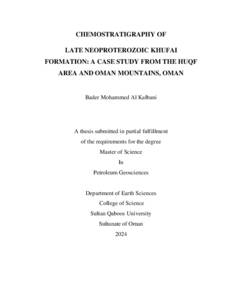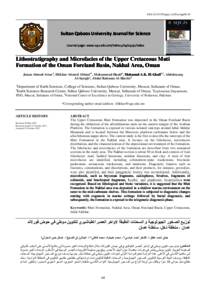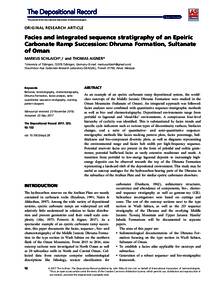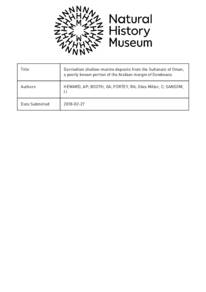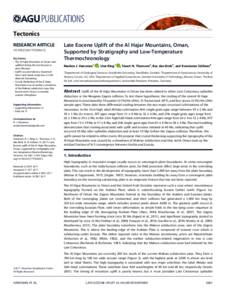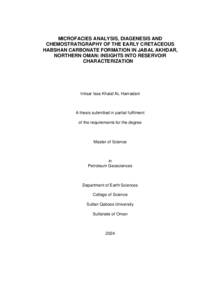وثيقة
Chemostratigraphy of late neoproterozoic Khufai formation : a case study from the Huqf area and Oman mountains, Oman.
المصدر
Master's thesis
عناوين أخرى
الكيمياء الطبقية لتكوين خوفي من العصر النيوبروتيروزوي المتأخر : دراسة حالة من منطقة الحقف وجبال عمان، عمان
الدولة
Oman
مكان النشر
Muscat
الناشر
Sultan Qaboos University
ميلادي
2024
اللغة
الأنجليزية
نوع الرسالة الجامعية
Master's thesis
الملخص الإنجليزي
This thesis presents a comprehensive geochemical and sedimentological analysis
of the Khufai Formation within the Neoproterozoic Nafun Group in Oman, focusing on
two key outcrops: the Huqf area (Khufai East Dome) and Wadi Hajer. Detailed
sedimentological logging was conducted along depositional dip profiles in both sections,
emphasizing color, lithology, grain components, bed thickness, bed contact nature, lateral
continuity, and fossil content. A total of 303 fresh carbonate samples were collected and
classified into bindstone, Wackestone and mudstone facies based on field observations
and petrographic studies.
Using XRF analysis, the elemental composition of each sample was determined,
identifying over 42 elements. Key elements such as silicon, cadmium, strontium, and
calcium were used as proxies to differentiate between the proximal (Huqf area) and distal
(Wadi Hajer) parts of the formation. The analysis revealed that silicon concentration
trends indicate the Huqf outcrop as the proximal part and Wadi Hajer as the distal part.
Additionally, the XRF technique proved effective in identifying periods of regression and
transgression, further enhancing our understanding of the Khufai Formation's
paleoenvironmental and depositional history.
Another primary objective of this study was to compare the XRF results with
previous carbon-13 isotope studies. By comparing these results with carbon-13 isotope
data, the study aims to better understand the depositional environment and sea-level
changes. This integration of field and laboratory data not only clarifies the depositional
dynamics of the Khufai Formation but also demonstrates the utility of geochemical
proxies in paleoenvironmental reconstruction. The findings provide significant insights
into the sedimentological and geochemical processes that shaped the formation,
contributing to broader geological knowledge and potential hydrocarbon exploration
strategies in the region.
الملخص العربي
تقدم هذه الرسالة تحليلا شاملا جيوكيميائيا ورسوبيا لتكوين الخفي ضمن مجموعة نفون في العصر النيوبروتيروزوي في سلطنة عمان، مع التركيز على منطقتين رئيسيتين: منطقة الحقف (قبة الخفي الشرقية) ووادي الهجير. تم إجراء دراسة رسوبية مفصلة على طول المحاور المترسبة في كًل المقطعين، مع التركيز على الألوان، والجيولوجيا، ومكونات الحبيبات، وسماكة الطبقات، وطبيعة التًلمس بين الطبقات، والاستمرارية الافقية، ومحتوى الحفريات. تم جمع 303 عينة من الكربونات : الحجر الدبقي، والحجر الواكي، والحجر الطيني، وذلك بناء على الملاحظات الميدانية والدراسات تحت المجهر.
. من خلال تحليل الفلورية بالأشعة السينية (XRF)، تم تحديد التركيبة العنصرية لكل عينة، حيث تم التعرف على أكثر من 42 عنصرا. استُخدمت عناصر رئيسية مثل السيليكون والكادميوم والسترونتيوم قف( عن الاجزاء البعيدة )وادي هجير من التكوين.
أظهرت التحليلات أن تركيزات السيليكون تُشير إلى أن مقطع الحقْف يمثل الجزء القريب، بينما يمثل وادي هجير الجزء البعيد. بالاضافة إلى ذلك، أثبتت تقنية XRF فعاليتها في تحديد فترات الانحسار والتقدم البحري، مما ساعد على تعزيز فهمنا للتاريخ البيئي والرسوبي لتكوين الخفي. كان الهدف الاساسي الاخر لهذه الدراسة هو مقارنة نتائج XRF مع الدراسات السابقة لنظائر الكربون.13- من خلال مقارنة هذه النتائج مع بيانات نظائر الكربون،13- تسعى الدراسة لفهم أفضل للبيئة الترسيبية وتغيرات مستوى البحر. يساهم هذا التكامل بين البيانات الميدانية والمخبرية في توضيح ديناميكيات الترسيب في تكوين الخفي، ويظهر أي اضا فائدة الادلة الجيوكيميائية في إعادة بناء البيئات القديمة. تقدم النتائج رؤى مهمة حول العمليات الرسوبية والجيوكيميائية التي شكلت التكوين، xvi مما يساهم في إثراء المعرفة الجيولوجية العامة وتطوير استراتيجيات استكشاف الهيدروكربون المحتملة في المنطقة.
. من خلال تحليل الفلورية بالأشعة السينية (XRF)، تم تحديد التركيبة العنصرية لكل عينة، حيث تم التعرف على أكثر من 42 عنصرا. استُخدمت عناصر رئيسية مثل السيليكون والكادميوم والسترونتيوم قف( عن الاجزاء البعيدة )وادي هجير من التكوين.
أظهرت التحليلات أن تركيزات السيليكون تُشير إلى أن مقطع الحقْف يمثل الجزء القريب، بينما يمثل وادي هجير الجزء البعيد. بالاضافة إلى ذلك، أثبتت تقنية XRF فعاليتها في تحديد فترات الانحسار والتقدم البحري، مما ساعد على تعزيز فهمنا للتاريخ البيئي والرسوبي لتكوين الخفي. كان الهدف الاساسي الاخر لهذه الدراسة هو مقارنة نتائج XRF مع الدراسات السابقة لنظائر الكربون.13- من خلال مقارنة هذه النتائج مع بيانات نظائر الكربون،13- تسعى الدراسة لفهم أفضل للبيئة الترسيبية وتغيرات مستوى البحر. يساهم هذا التكامل بين البيانات الميدانية والمخبرية في توضيح ديناميكيات الترسيب في تكوين الخفي، ويظهر أي اضا فائدة الادلة الجيوكيميائية في إعادة بناء البيئات القديمة. تقدم النتائج رؤى مهمة حول العمليات الرسوبية والجيوكيميائية التي شكلت التكوين، xvi مما يساهم في إثراء المعرفة الجيولوجية العامة وتطوير استراتيجيات استكشاف الهيدروكربون المحتملة في المنطقة.
قالب العنصر
الرسائل والأطروحات الجامعية

